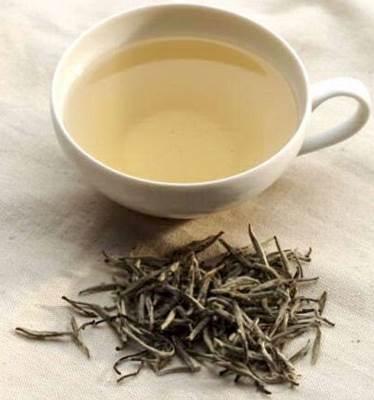
Over the next few weeks, we will take a look at the “classic” Chinese teas — white, green, yellow, oolong, black and brick — and discuss the regions where they grow, the process each tea undergoes before it can be brewed, and the brewing techniques as well as descriptions of the different aromas, tastes and feelings that can accompany each variety. We’ll start at the beginning, with white tea, because it is the least processed tea and also, in a way, the first tea to be plucked from the bush.
White Tea
White tea is called white because only “baby” leaves are used to make white tea. The young leaves from the Camellia sinensis plant grown in Fujian Province along the eastern seaboard of China are white with fuzzy hairs. The bushes often have silver-tipped leaves in the first months of spring; these are the leaves used to make the famous Yin Zhen Silver Needle and the Bai Mu Tan white teas. Few other provinces in China grow or process white teas in large (or famous) quantities. The reasons behind this are historical more than ecological.
Conditions Needed to Grow Good Tea
The conditions to grow good tea exist in any place with mountains, slight rain and fog, and heavy vegetation, but in China, most tea producers focus on their own local variety. For example, in Sichuan, most green teas come from the Chuancha variety of the Camellia sinensis plant, which produces an emerald colored tip that is shaped like a curved spearhead or an elongated teardrop. In Zhejiang, the tea plants there produce the famous Dragonwell Green, which is usually forest green, flat and a little broader than the Chuancha tea. Both regions are capable of growing either variety, but centuries create habit and, above all, tradition.
Chinese Teas
Back to white tea. The Fujian region was, is, and most likely always will be, China’s preeminent grower and producer of this delicate tea. White teas are also grown in Assam in India, Ceylon or Sri Lanka and parts of Africa. These teas are picked and processed from plants taken (or stolen) by the British. I am going to focus on the Chinese teas, because for me, China is the source.
White tea is a very special tea because it is very labor intensive in the beginning, when each fuzzy white baby leaf is plucked by hand from the plant. The highest quality white tea is comprised of uniform white leaves only. The descending grades are basically larger or older white leaves and/or white leaves mixed with darker green leaves and stems.
White Tea Picking Season
There is a small window of opportunity for white tea in Fujian. From early April to early May is usually the best time to pick white teas. Some plantations are able to pick earlier, mid-March for example, and there are also plantations that are able to get high quality fuzzy white leaves into late May. This is a purely ecological thing — the arrival of spring, whenever that may be in each region, heralds the white tea picking season.
How They Grade the Tea
The varying grades of white tea are a function of the season and also the process. The older the leaf, the lower the grade. The more intense the sifting process — as in, the more work is put into picking and choosing perfectly formed, unbroken fuzzy white baby leaves — the higher the grade and the more expensive the tea.
White tea is unoxidized, uncured, not rolled, not roasted, not anything. Some growers simply lay the leaves out in the sun, let them dry and then pack them up for storage in coolers. What little is done to the leaves — such as sifting, or slight tumbling — is done by hand. There is no choice. Once you put these little babies in a machine, you destroy the leaf and you don’t have white tea anymore. You have broken baby leaves that are considered undrinkable.
White Tea is the ‘First Tea’
So white tea is effectively tea in its rawest form — the first tea. This is what makes this tea special and beautiful. According to legend, the first tea was a leaf that blew into an Emperor’s cup as he rested on a tour through his lands. Historically, we know that the Song Dynasty painters, poets, singers and aristocrats loved to drink white tea. They ground it down and whisked the white powder into cups and bowls and then drank the golden brew and began composing. You can do this today if you want; there is no reason why you cannot grind down some really good Yin Zhen tea and whisk your own powder into your own bowl. The feeling is quite heady.
Health Benefits of White Tea
Because of the fact that white tea is “raw,” so to speak, many health benefits have been attributed to drinking the brew in the centuries since the first shocked Emperor sipped delicately from his cup. Recent research has confirmed that white tea is high in catechins, which helps to reduce cholesterol. It has also been found to “inhibits adipogenesis in human subcutaneous (pre)-adipocytes” — IE helps you lose weight.
White Tea Considered as ‘Feminine’ in China
In China, white tea is considered to be a very feminine tea. Perhaps this is because it is a virgin tea? Because it is pure and delicate and beautiful? In China there is a saying, women are made of water; men are made of mud. So white tea can be understood to be feminine in nature if seen in such a light. But if you ask someone in China today, they will tell you it is due to the effects white tea has on skin. White tea contains antioxidants, is antiviral and antibacterial, and stimulates blood flow. According to Chinese medicine, these properties can help you “stay young” and for women, maintain soft, supple skin.
Again, tea in general can do this, but the raw, young baby leaves of the white tea variety are understood to be the “most potent.”
Now to the Fun Part: Brewing and Drinking
White tea has a very soft and delicate taste, in general. It can range from so soft it seems like you just dropped some white petals into water to a sweet brew, like hot water with a dollop of fresh honey. Yin Zhen tends to be more delicate in nature, whereas the Bai Mu Tan can be a stronger, more flavorful brew. The younger the leaf, the more refined, subtle and delicate the taste.
You can tease all of these tastes out of any white tea variety through an understanding of brewing. A Yin Zhen that is steeped for a longer period of time can produce a strong flavor and conversely a Bai Mu Tan “flash” steeped can be delicate.
Think about this tea before you brew it. It is a baby leaf. No need to use hot boiling water here, because you will destroy it. One way that I have brewed delicate whites and greens with good results is by first using a little bit of cool water — just a tiny bit to cover the tea you are using — to kind of “open the tea” a bit and prepare it for the hot water. It also helps to keep the shock of the hot water to a minimum. After just a few seconds, pour in your hot water. Steep for a minute or two and then pour to drink. With this technique, I like to use a glass — no pot at all, just a glass.
Another way is to use a porcelain Gaiwan cup. With a Gaiwan, the heat of the water is coming out of the top where the cover usually sits loosely. I tend to just pour the hot water (we’re talking high 80 to mid 90 here) right in there and then lift the cover a few times and swish the tea a bit in the Gaiwan. This technique works fine, and I get three to four steeps out of a good white tea.
Brew White (or Green) Tea in a Square Clay Pot
I have never used a clay pot with white tea, but I see no reason not to. I was told by a master that greens and whites are best brewed in a square clay pot as opposed to a round one, so keep this in mind if you are going to use clay. He never gave me a clear reason why, but it actually makes sense. With an Yixing clay pot for example, I will only brew oolongs or brick (puer) teas. Maybe a black. The earthy warmth of these teas requires clay. Whereas the delicate airy greens and whites (and yellows) like glass or porcelain.
As always, experience is the best teacher. Realize with whites that you are dealing with a baby and if you brew it accordingly, you should have the same look of eureka written across your face that the legendary Emperor had way back when.
 Sascha Matuszak is a German-born American writer and is currently based out of Chengdu, Sichuan Province, China.
Sascha Matuszak is a German-born American writer and is currently based out of Chengdu, Sichuan Province, China.
CactusHeart says
Sascha’s right…there IS NOTHING like enjoying white tea you just freshly ground. The same thing with coffee, but moreso with tea *lol*. It’s a real rare luxury to do though, especially with white tea, because it’s so much more expensive whole. If you see white tea go for cheap, odds are it’s a blend sharing space with green tea, herbs and other junk (like the reject leaf parts or stems) *lol*